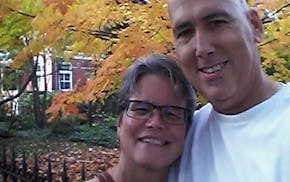Perhaps it's the large, trusting eyes and the smooth, bald head that make us want to believe in Daniel Hauser. He never speaks, but seems composed and mature in front of television cameras, a silent Buddha upon whom we can project wisdom.
Maybe that's why so many readers and talk-radio listeners were willing to believe that a 13-year-old boy could be a church elder and a medicine man; after all, he even has the papers to prove it. Maybe it's why they believed he could understand his own mortality and make hard decisions about his own health care.
Sadly, nothing could be further from the truth.
Not only could Daniel neither read nor understand the affidavit he signed saying he preferred "native" treatments over chemotherapy for his Hodgkin's lymphoma, but he also could not read. Period. When tested by his teacher for entrance into a charter school, according to court documents, Daniel, who had been home-schooled, could not identify the following word:
"The."
A court in New Ulm on Friday correctly decided that Hauser, or more accurately his parents, could not deny Daniel medical treatment that will likely cure him of a disease that would otherwise kill him. It is indeed distasteful to picture doctors restraining Daniel to give him chemotherapy. His parents can make sure that doesn't have to happen.
The only thing more distasteful, shameful really, would have been to let a frightened little boy elect to kill himself, to let his well-intentioned but misguided parents neglect him to death.
Alternative remedies have become almost mainstream, as most doctors encourage them in conjunction with the science and art of traditional medicine. But as Al Carroll, a Mescalero Apache professor, told me, Native Americans' biggest complaint is a lack of access to good modern medicine.
Most parents I know say they would practically sell their souls to save their child. I have no doubt the Hausers were doing what they thought was best. So I can only conclude they are being duped.
As I reported last week, the man who runs the Nemenhah Band, to which the Hausers became members by paying a fee, has been convicted of grand theft and theft by deceptive practices at least twice. Another member of the group used the loophole that allows for Native American spirituality in order to sell peyote. Dan Zwakman, who the Hausers claim is their medicine man, is a former police officer.
The judge in the case said, "It is clear these statements of the principles of Nemenhah are not being generated by either of these witnesses [Daniel or his mother]." No, it was grown-ups playing Indian and jeopardizing lives.
Daniel testified his mother told him he had become a medicine man, but only after his first chemo treatment. Turns out everyone in the church becomes a medicine man automatically at 13. I'm guessing fees are involved. But Daniel couldn't explain the term, nor could he describe basic church doctrine, according to court documents.
Daniel is not an isolated case. Rita Swan, executive director of Children's Health Care Is a Legal Duty, based in Iowa, said her group's studies show that most of the children who died over a 20-year period because of religion-related medical neglect -- 140 of 172 -- had a 90 percent chance or better of surviving had they received conventional treatment, just like Daniel. She said that while Minnesota law has improved in protecting kids, it is still insufficient.
"Minnesota law says prayer is health care -- that makes it difficult," she said.
Those who claim alternative medicines are the cure to everything lack science to prove it. Instead, they feed off anecdote, the friend-of-a-friend who recovered from a horrible disease because of a good dose of cumin. But as someone involved in the case put it to me, "the plural of anecdote is not data." Science says Daniel has a 5 percent chance of survival without chemo.
But for those of you who do like a good anecdote, I'd like you to meet Sarah Sandquist. She is 19 and healthy precisely because she believed her doctors at Children's Hospitals and Clinics of Minnesota and underwent chemotherapy at age 13.
Like Daniel, Sandquist had Hodgkin's lymphoma. Like Daniel, she was afraid. Like Daniel, the chemotherapy made her feel terrible.
"The first time was the worst," said Sandquist, who is now a freshman at the University of Minnesota. "It made me nauseous. But the doctors gave me medications and it wasn't as bad after that. I had a tutor at home for awhile, but I went to church meetings and just hung out with friends when I felt better.
"I understood that what was making me feel horrible was really going to make me feel better," Sandquist said.
Jon Tevlin • 612-673-1702

Tevlin: 'Against all odds, I survived a career in journalism'

Tevlin: Grateful Frogtown couple fight their way back from fire and illness



